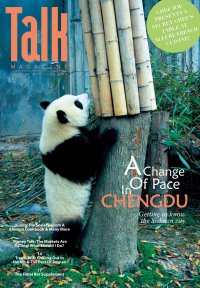Eating Chengdu with Robyn Eckhardt

Photos by Dave Hagerman
Robyn Eckhardt moved to Chengdu in 1984, and once she started sampling the local cuisine, she was a goner. A culinary love affair that has stood the test of time, Eckhardt has repeatedly returned to the region, usually with her food photographer husband Dave Hagerman in tow, to immerse herself in the famous spicy flavours. Now based in Malaysia, she writes the award-winning blog Eating Asia – accompanied by Hagerman’s beautifully pictures – and has espoused the wonders of Sichuan and other Asian cuisines on the pages of New York Times, Saveur, Food & Wine, Wall Street Journal Asia and South China Morning Post.
How did your move to China in 1984 spark this interest in all things spicy and Asian?
Chengdu was a culinary watershed for me. I grew up with a typically (for the 1960s/70s) American Midwestern, somewhat tame palate. Oily chili-laden food was new to me, as were ingredients like tofu, fatty pork and huajiao [Sichuan peppercorn], and dishes such as stir-fried leafy greens. But for some reason I took to it all immediately; other than sea slug, I can’t remember encountering anything I didn’t like.
.jpg) And though I was in the middle of nowhere – compared to, say, Beijing or Shanghai -- it was actually a lucky thing that I ended up in Chengdu, because Sichuan was one of the first provinces to liberalize agriculture under Deng Xiaoping’s economic reforms. So we had a bountiful free farmer’s market (rather than just state-owned produce shops) with a huge variety of really gorgeous produce steps from the university gate. And Sichuan’s semi-tropical climate meant that while folks in Beijing were eating cabbage we were feasting on beautiful beefeater-type tomatoes, sweet corn, peas and doumiao, rabe, blood-red carrots and all sorts of other lovely veggies.
And though I was in the middle of nowhere – compared to, say, Beijing or Shanghai -- it was actually a lucky thing that I ended up in Chengdu, because Sichuan was one of the first provinces to liberalize agriculture under Deng Xiaoping’s economic reforms. So we had a bountiful free farmer’s market (rather than just state-owned produce shops) with a huge variety of really gorgeous produce steps from the university gate. And Sichuan’s semi-tropical climate meant that while folks in Beijing were eating cabbage we were feasting on beautiful beefeater-type tomatoes, sweet corn, peas and doumiao, rabe, blood-red carrots and all sorts of other lovely veggies.
By the time I returned to the US, the way I cooked and ate had been completely transformed. For the better, I think. And after almost 10 years living in southeast Asia, and loving the food here, Sichuanese remains my favorite Asian cuisine.
What are the biggest changes to Chengdu’s food scene since you first lived there?
No more ration tickets for pork and wheat products! And even at the most humble fly restaurants dishes have much more meat in them now than back then. In 1984 an order of huanggua rousi might have at most 100grams of pork in it, sliced paper thin to make it go further. Suan la tang would consist of mostly shredded chili-pickled cabbage with just a few shavings of meat. Not that that was a bad thing, I never missed meat.
People seem to eat much less rice now, at least when they’re eating out. At the one ‘restaurant’ out the back gate of Chuan Da where we ate every night you ordered rice by the jin, usually 2 or 3 in one sitting. And then you’d just have a few very protein-light dishes to go with it.
There’s less street food now – a sad consequence of urbanization, redevelopment, and efforts on the part of the municipal government to make Chengdu a ‘wenming’ city.
Chengdu was named the first ‘City of Gastronomy’ in Asia by UNESCO. What is it about this city and its food culture that makes it stand-out in a region of such amazing cuisines?
Well I’m biased because I think Chengdu is one of the greatest places in the world to eat. It comes down to Chengdu ren themselves. I think of them as the “Italians of China” in that, much like Italians, Chengdu ren really know how to live – they place a priority on enjoying themselves. You see and feel it all over the city – folks idling in tea gardens, playing mahjong and cards, hanging out in parks and eating with obvious relish. Any population that places a priority on good living is going to value food, and that in turn is likely to make for an intricate, wonderful cuisine AND for efforts to preserve that cuisine.

